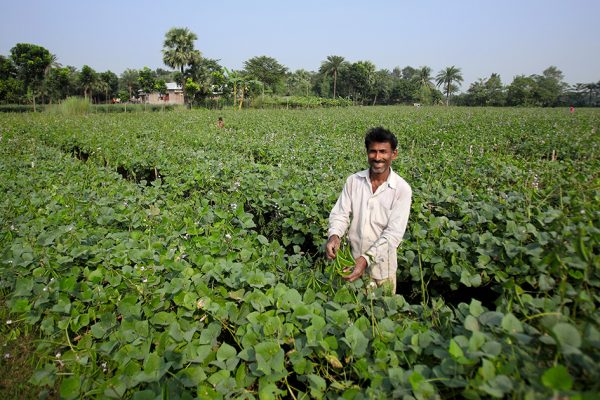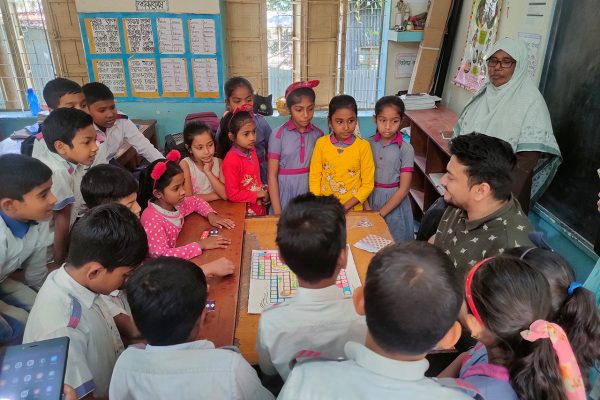Aarong: Crafting hope, weaving dreams
Reading Time: 5 minutes
Artisans make products for Aarong, a fashion house that supports the lives and livelihoods of 65,000 rural artisans and handicraft producers. Photo: BRAC/Shehzad Noorani

Artisans make products for Aarong, a fashion house that supports the lives and livelihoods of 65,000 rural artisans and handicraft producers. Photo: BRAC/Shehzad Noorani
Shondhya Rani Sarkar’s eyes light up when she speaks of how well her son is doing in school. When Shondhya first came to the Aarong Production Centre in Manikganj, he was a year old. The self-assured Shondhya of today was then a desperate young widow with no means to feed her baby.
She joined a local microfinance group of the NGO Brac and was recommended for employment with a nearby Aarong production centre, where women like her could earn a decent living without endangering their dignity. That was 15 years ago.
Today, Shondhya is one of the most experienced block print workers at the centre, training new recruits. Working 8 am – 5 pm shifts, six days a week, she earns a steady income that could easily rival that of any men-lead family’s in her village. Her life is not easy, but Shondhya gains satisfaction from the thought that she has provided for her son and ensured a brighter future for him — one that fifteen years ago had seemed to her an impossible dream.
Shondhya’s story is hardly exceptional, but it is in the slow and steady changing of the lives of thousands of Shondhyas across Bangladesh that we are brought face to face with the true impact of an organisation, which has so far come into the limelight only for its commercial success.
A lot of us grew up with Aarong. In homes around urban Bangladesh, it has become a household name. Yet, Aarong’s true beauty does not lie in the air-conditioned confines of its outlets around the country with which we are all familiar. For all its business success and conquest of trends, Aarong’s strength comes from a far more humble yet purposeful beginning, a history with which most of us remain unfamiliar.
Aarong began as a means to an end for a quiet organisation fighting to uphold the dignity of the marginalised. In 1976, when Brac first began encouraging sericulture for women in Manikganj, their only buyers were a few scattered retailers in Dhaka. Weeks, even months would pass between supply and payment, until Brac intervened. Aarong was born out of a need to ensure that these penniless silk farmers of Manikganj were paid for their goods on time, so that they could feed their families.
Today, holding steadfast to its original mission, Aarong supports the lives and livelihoods of some sixty-five thousand rural artisans and handicraft producers. Women like Shondhya make up half of its producer base — that is more than thirty five thousand disadvantaged women who are now supporting their families. And since every woman who works in the Aarong production facilities also has access to Brac’s multifaceted development programmes, the support they receive extends well beyond simply their wages.
Then there are independent producers who supply to Aarong everything from coin purses to silver bracelets. Each of these small entrepreneurs is a success story with manifold impact.
Khodeza Begum, as a good example, has been with Aarong since the beginning. As a child, her interest in embroidery turned into a source of income during the early 1970s, when her husband’s income was not enough to support their family. Her expertise with the ‘Nakshikantha’ caught the eye of someone at Aarong and soon orders followed. In no time, the orders reached sizes she alone could not handle. Starting first with the women in her family and then those in neighboring families and beyond, Khodeza trained a rank of Nakshikantha craftswomen who formed the basis of what has today grown into a successful small business working solely to supply Aarong.
Khodeza Handicrafts now employs more than 400 women in Jamalpur, Tangail, Kushtia and Narayanganj — particularly depressed areas chosen by Khodeza, so her business can create opportunities for rural women similar to what Aarong has provided for her. When Khodeza speaks of her business or Aarong, it is with equal pride and an equal sense of ownership. For her they are one and the same. What matters in the end, she says, is, “What we are doing for our people.”
Whether it is by direct involvement, or in a ‘pay it forward’ manner, Aarong as an organisation operates on what is known in the business world as the ideal ‘double bottom line approach’. Creating positive social impact is its primary and fundamental goal, where business performance plays a crucial yet secondary role as a way to sustain and expand the breadth and scope of this impact.
Meanwhile, on the business operations end, Aarong has steadily groomed itself into a well-oiled machine, keeping a watchful eye on the other ‘bottom line’. The kind of attention it puts into controlling the quality of its wares remains largely unrivaled by even the most consumer-friendly enterprises in the country. As a result, Aarong’s products have secured the trust of even the most scrutinising buyer, at home and abroad. This, and the amount of energy and creativity expended in marketing, has imposed upon Aarong an aura of glitz and glamour.
To the naked eye, there is little connection between the organisation and the artisans that are its backbone. But that is because most of us have never been to Aarong’s 13 production centres or 624 sub-centres spread across Bangladesh.
Bangladesh’s handloom industry has enjoyed a rather intimate symbiotic relationship with Aarong. In areas such as Chapainawabganj and Norshindi, some weaver communities are entirely dependant on Aarong’s fabric consumption for survival. Last year alone, this amounted to almost 6.45 million yards of hand-woven fabric.
Aarong’s marketing strategies have also achieved something equally important: bringing consumer attention back to products and styles indigenous to Bangladesh. Just as interest in imported fashion was piquing, Aarong’s blending of the traditional and the contemporary won instant consumer appeal, starting a revolution in trends that has now been taken up by countless other stores and boutiques.
Not many are aware of the role Aarong has played in protecting and promoting traditional crafts and designs from its inception. Perhaps part of the secret behind Aarong’s success with setting new standards in fashion lies in the age-old patterns it has resurrected from Nakshikantha art and pitha molds — designs that were otherwise slowly getting lost amidst the clamour for foreign products and imported styles. Many will be surprised to learn that Aarong houses an extensive design library where our rich craft heritage, be it Nakshikantha art or lost Jamdani pattern, have been widely researched and archived for present as well as future use.
But perhaps the most remarkable aspect of an organisation as visibly profitable as Aarong is that, as a support entity of Brac, half of its surpluses go directly into financing the NGO’s development programmes. In the simplest of terms, after the in-house operating costs and overheads are settled, this retail giant functions as an income generating activity for Brac, helping to finance its fifty thousand schools, countrywide tuberculosis treatment programme or legal education classes.
Today, Aarong opens the doors to its flagship store, Bangladesh’s biggest retail outlet, in Uttara. True to the Aarong tradition of continuously raising the bar, this store utilises state of the art layout and décor to create an unparalleled shopping experience. And while buying a sari from Aarong may still be a luxury for some of us, at least we can appreciate the fact that somewhere in Bangladesh, a woman travelled forty minutes on foot to put a hundred year-old kolka print on its aanchol. We will know that while one of Khodeza’s women takes home some of the money that we pay at the counter, part of it also goes towards Shondhya’s daughter’s school books. As long as we can afford to keep buying Bangladeshi, as long as Aarong’s business is booming, thousands of people will enjoy the luxuries of steady employment — getting a decent pay on time, going home to healthy, educated children.
The next time we are at Aarong looking over their candles or cushion covers, we might stop to take pride in what is a truly remarkable Bangladeshi institution. Buying something at Aarong might be a better shopping experience knowing that it is a luxury we can afford to feel good about.
Q. Pushpita Alam





